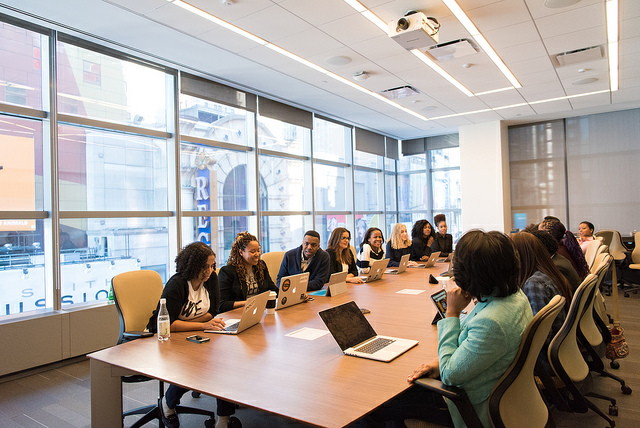 Have you ever had to moderate a panel for a conference? Panels can be tricky. They can be either a highlight of the meeting or a lowlight. Rebecca has been asked to moderate a number of panels, so I ask her to pass on some hints she has learned over the years.
Have you ever had to moderate a panel for a conference? Panels can be tricky. They can be either a highlight of the meeting or a lowlight. Rebecca has been asked to moderate a number of panels, so I ask her to pass on some hints she has learned over the years.
If you’re in charge of putting the panel together:
- Find out what your target audience wants to hear. Interview a representative sample of the people most likely to attend. Ask them what they would most like to have addressed by company/industry/ subject leaders. Who would they like on that panel? What specific questions would they have for the panelists?
- Choose your panelists carefully. Make sure you have a good representation of appropriate resources (e.g., male/female, corporate/consultant.) I have sometimes called prospective panelists asking the question above to see how articulate they are. If they have interesting thoughts on the topic and can express them clearly, I will call them back and ask them to be panelists.
As moderator:
- Be clear on your role. Are you a moderator or a panelist or both? If just the moderator, your job is to be the glue that holds the parts together. This means you are not a panelist. Don’t be tempted to answer questions yourself or participate as a panelist. This is hard when you have some knowledge of the topic.
- Gently coach your panelists. Sometimes you don’t have a choice who is on the panel, and you may have a long-winded panelist or someone who will read his/her comments. In a confirmation letter to all panelists, you could include some suggestions of what made past panels successful. Panelists who have been viewed as most successful in the past were those who:
- Spoke from notes, but didn’t read their comments.
- Had thought about the topic and audience ahead of time, and focused their comments to the audience.
- Appeared relaxed and comfortable.
- Guide your panelists on how to respond during questions and answers. Explain that the following are guidelines for responding to questions:
- If you are asked a question you don’t have an opinion or information on, quickly pass so another panelist can answer.
- If you don’t have anything different from another panelist to contribute, don’t say anything.
- Work to be concise in your answers so more questions can be entertained.
- Time each panelist so one or two don’t take up the majority of time. Let them know they will be timed and when their time is up, have someone in the back hold up a sign. Divide your total time into approximately 1/2 to 2/3 for the panelists’ comments, with the rest for Q&A.
- Include a sentence on why they were chosen to be on this panel in the introduction of each panelist. Edit any prepared introduction they give you to a few paragraphs on why they are a credible resource to be discussing this topic. For most business audiences it is not relevant where they went to college, or how many years they’ve been married, or how many children they have.
- Introduce each panelist before she/he speaks. This breaks up the monotony of each panelist speaking successively. Besides, if you introduce them all at once, no one will remember the salient points about them when it’s their turn to speak.
General hints:
- Control the physical set up. If the panelists are not on a riser, ask each to stand when delivering his/her comments. If they don’t, the people in the back of the room won’t be able to see them and will lose interest. Whether on a riser or not, I often dispense with a table and ask that the panelists’ chairs be set up in a slight semi-circle. This gives a more approachable look to the panelists, and it makes for a more relaxed atmosphere. I have standing microphones set between every other panelist so each can pull the mic out of its stand to speak, or I provide lavaliere mics for everyone.
- For questions and answers, there are several options. You could have people write down their questions on 3 x 5 cards placed around the room and collected by “runners” and brought to you, the moderator, or to someone who will screen them and prioritize them. This works well for larger groups, or if you think the audience may be hostile or ask questions that would embarrass the panel. The other option for entertaining questions is to allow members of the audience to ask the panelists directly. If the group is large enough, you could have standing mics placed in the aisles and ask people to come to a microphone to ask their question. Or you could have several people roaming the audience with wireless micro-phones, handing them to people who have their hands raised. Make sure to have the questioners stand up whether a mic is used or not.
If a mic is not used, repeat the question if you think the whole audience can’t hear it; it also gives the panelist time to formulate his/her answer.
Before the question and answer period, I ask the audience for their cooperation on a few items, to make sure that this part goes smoothly.- “Please ask questions, vs. making contributions. We know there are many people in the audience with information on (subject), however, we’ve asked these people here to share their expertise. If you have some additional information for a specific panelist please discuss it with him/her afterward.” I’ve found that some people want to show the rest of the group that they are just as knowledgeable as the panelists, and may resent not being asked to be on the panel. They want everyone to know that.
- “In order for as many questions to be asked as possible, please direct your question to only one panelist, rather than to the whole panel.” I find it tedious as an audience member to have each panelist answer a question of marginal interest to anyone but the questioner. If they don’t ask the question to a specific individual, then you ask someone who you think would be most qualified to answer.
- “In the interest of time, please make your question brief and concise.” I’ve had to gently interrupt a questioner’s story with “What is the question you have?” Don’t let them babble on.
- End with a summary of the information and ask the audience to thank the panelists for their contribution.
 Executive Speech Coach and Hall of Fame Keynote Speaker, Patricia Fripp is hired by individuals and companies who realize that powerful, persuasive presentation skills give them a competitive edge. She and her expert associates are the ultimate destination if you want to improve the quality of your public speaking, executive presentations, sales presentations, or if you are looking for a keynote speaker for your meetings, conventions, and corporate events.
Executive Speech Coach and Hall of Fame Keynote Speaker, Patricia Fripp is hired by individuals and companies who realize that powerful, persuasive presentation skills give them a competitive edge. She and her expert associates are the ultimate destination if you want to improve the quality of your public speaking, executive presentations, sales presentations, or if you are looking for a keynote speaker for your meetings, conventions, and corporate events.
photo courtesy of WOCinTech [FLICKR]





Add Comment